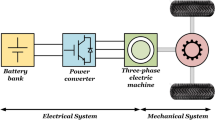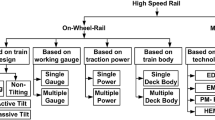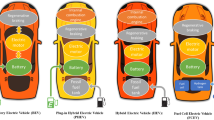Abstract
A hydraulic power-assist system is a hydraulic regeneration system that can significantly improve fuel economy when installed on a conventional bus operating in urban traffic. This paper presents a methodology for matching a new hydraulic power-assist system (HPA) to a conventional bus. The HPA and the conventional bus were modeled using the AMESim environment. The HPA was optimized using a simulation-based orthogonal design method with two indexes, the fuel economy and the acceleration performance. According to the simulation results, the volume of the accumulator was the primary factor affecting fuel economy, and the gear ratio of the transfer case was the primary factor influencing the acceleration performance. As a result, tradeoffs between the two indexes are required for a practical operational scenario. Experimental results demonstrated that the optimal HPA installed on a conventional bus was able to satisfy the acceleration performance requirement of the vehicle and also reduced fuel consumption by 25 percent.
Similar content being viewed by others
References
Booth, A. E., Muneer, T., Kirby, J., Kubie, J. and Hunter, J. (2001). The measurement of vehicular driving cyclewithin the city of Edinburgh. Transportation Research, Part D, 6, 209220.
Hewko, O. and Weber, R. (1990). Hydraulic energy storage based hybrid propulsion system for a terrestrial vehicle. Proc. Intersociety Energy Conversion Engineering Conf., 4, 99–105.
Imagine, S. A. (2003). AMESim User Manual. Version 4.1.
Lei, T. J. (1998). Handbook on New Hydraulic Engineering. Beijing University of Science and Technology Press.
Park, Y. H. and Hong, S. Y. (2006). Hybrid power flow analysis using sea parameters. Int. J. Automotive Technology 7,4, 423–439.
Pourmovahed, A., Beachley, N. H. and Fronczak, F. J. (1992a). Modeling of a hydraulic energy regeneration system-Part I: Analytical treatment. J. Dynamic systems, Measurement, and Control, ASME 114,1, 155–159.
Pourmovahed, A., Beachley, N. H. and Fronczak, F. J. (1992b). Modeling of a hydraulic energy regeneration system-Part II: Experimental program. Trans. ASME, 114, 160–165.
Wu, B., Lin, C. C., Filipi, Z., Peng, H. and Assanis, D. (2004). Optimal power management for a hydraulic hybrid delivery truck. Vehicle System Dynamics 42,1–2, 23–40.
Wang, B. H., Luo, Y. G. and Zhang, J. W. (2008). Simulation of city bus performance based on actual urban driving cycle in China. Int. J. Automotive Technology 9,4, 501–507.
Author information
Authors and Affiliations
Corresponding author
Rights and permissions
About this article
Cite this article
Liu, G.Q., Yan, Y.C., Chen, J. et al. Parameter matchin and optimization for a hydraulic power-assistant system. Int.J Automot. Technol. 11, 573–580 (2010). https://doi.org/10.1007/s12239-010-0069-2
Received:
Revised:
Published:
Issue Date:
DOI: https://doi.org/10.1007/s12239-010-0069-2




